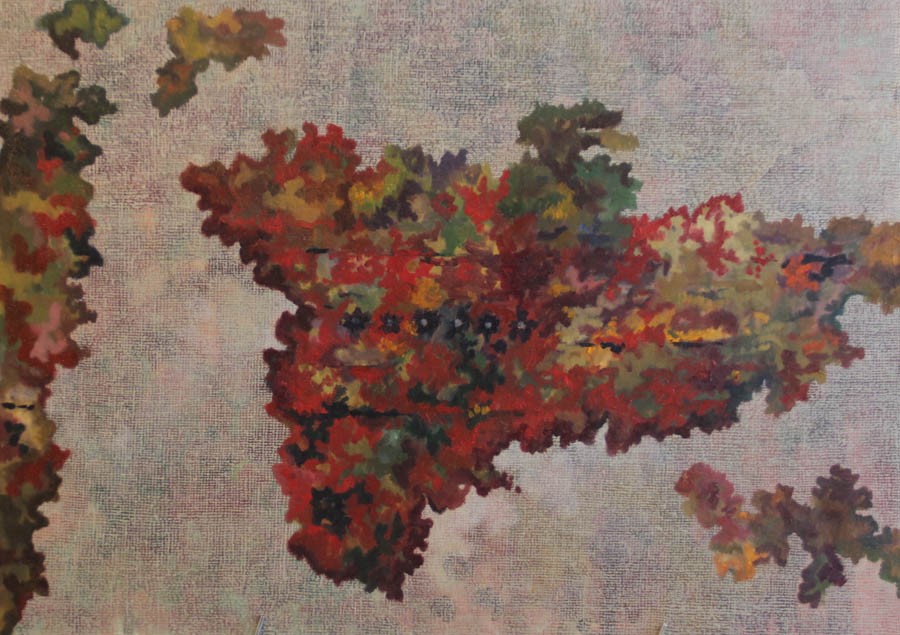
Anushka Rustomji digs Zoroastrian iconography and Marjan Baniasadi examines Persian rugs at Taseer Art Gallery Lahore

Parsi literally means ‘from Pars, the Persia’. In the context of subcontinent, it denotes the followers of Zoroaster who migrated from Persia and settled here. Sadly, Parsis are now becoming a fading community in Pakistan; many of them have migrated to countries where religious and ethnic minorities are not threatened by a dominating majority.
It wasn’t always like this here. People were recognised on the basis of their achievement rather than their faith or sects. It is only lately that the religious identity of a person has become important, no matter if it is linked to his work or not.
Consequently, artists have been discovering and using religious iconography in their works as marks of identity. In some cases, it happens naturally as part of one’s culture. Like Anushka Rustomji who has a Zoroastrian background which has influenced her work. Trained at the National College of Arts where she produced paintings about a variety of themes and imagery, it was during her Degree Show that she tried to explore her ancestral roots and her visual material related to Zoroastrian subjects.
In her recent work too, Rustomji is investigating her root. She digs deep and draws her references from a history that can be traced back to Babylonian and Assyrian periods. In her work from a two-person show Transition of Tradition at the Taseer Art Gallery Lahore (April 23-May 11, 2018). she displays a number of pieces made in galvanised metal, with perforated lines -- visuals that remind of a lost civilization. Her titles, ‘Assyrian Hoama’, ‘Ashtar Brick’, ‘Ashtar Gate Floral I, II, III’, ‘Winged Auroch’ and ‘Sumerian Merman’ also refer to that phase in human history which may have discontinued, yet its reminiscences are still part of a living culture, of people who pray in the Agiari (Zoroastrian place of worship), that has figures of Assyrian and Babylonian origins on its outer walls.
Rustomji has absorbed that kind of imagery and created pieces which are more personalised and lyrical. Employing water-based mediums to make works on paper that still relate to historic sources, this body of work addresses more than merely the past; it makes the tradition relevant and alive. No matter if an ancient pictorial practice is from Africa or Amazon, one can still associate with it, because it exists and operates on a shared ground: of instincts, feelings and desires. So when Anushka Rustomji translates the past into present, it transcends not only time but territory and religion; her work turns more universal, like the paintings in which figures from history (or mythology?) are clustered, combined and converted. Just the fact that these figures (drawn with a puncture tool on paper) are arranged on a paper, the composition does not connect to history but is modified for contemporary sensibility.
In the realm of literature too, writers have picked past texts and transformed them. Kamila Shamsie has appropriated Sophocles’ Antigone in her novel Home Fire. Before this, Intizar Husain infused narratives from Biblical scripture, Hindu mythology, Buddhist texts, and Muslim mystics’ writings in his short fiction to describe the contemporary situation.
Marjan Baniasadi, the other participant, also seeks to revitalise tradition. Hailing from Iran, she too studied at NCA before earning her MA Visual Arts from the same institution. She has been focusing on the pictorial aspects of carpet. Inspired from that (Persian) heritage, she has been exploring the visual components of this product which represents not only a formal convention but a way of looking at the world and transcribing it into knots, strands, hues, shapes and motifs.
Drawing from the tradition of Persian carpets, Baniasadi has created her paintings with elements of carpet weaving. So you see fragments of carpets repainted, they appear as their memories -- torn, fragmented, disjoined and dismembered. Her source of inspiration comes from her homeland, but she disfigures it, dismantles it and deconstructs it, in order to make an image that can be easily accepted and admitted in the aesthetics of contemporary.
Baniasadi’s surfaces are tactile, tender and sensitive, and these can envelope you in their visual intricacies and complexities, just like the experience of stepping on a carpet which receives you in its softness and comfort. Her work from the exhibition is remarkable in terms of her extrapolation of a traditional motif and modernising it for a purely sensuous purpose. Selective palette, subtle use of various hues, application of paint that connotes a carpet texture, and compositions that invoke landscapes and maps make her paintings distinct. Her sophisticated surfaces are a way of revisiting the past and at the same time a logbook entry of being away from the past.
In an uncanny way, the images of Marjan Baniasadi have become a metaphor for the situation for an individual and a conventional surrounding. Forsaking the strict structure of Persian carpet, Baniasadi indicates (parallel) possibilities to view, record and review the society through these age-old artefacts.
Yet the past is a perfect point to proceed for two participants of the exhibition. One has dug the Zoroastrian iconography from Near East, while the other has examined Persian rugs. Both have also collaborated to make a floor drawing (‘Ready-made Ruin’) in white powdered chalk, which looks like a carpet as well as an assemblage of visuals from ancient Persia and Mesopotamia. Blending the two traditions and times, actually both produced a single word/work: Parsi.